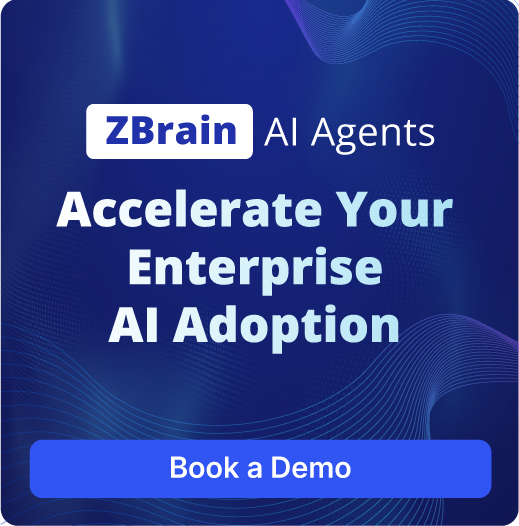
 Live
LiveCustomer Support Email Responder Agent
Monitors the email inbox for customer queries, retrieves answers from the knowledge base, sends replies, or creates tickets for unresolved queries.

 Live
LiveSmart Follow-Up Email Agent
Automates and personalizes follow-up emails to customers, ensuring timely responses and enhanced customer satisfaction.

 Live
LiveDynamic Query Resolution Agent
Resolves customer queries by first utilizing its knowledge base, and if needed, retrieves relevant information from integrated tools to provide accurate answers.

Technical Issue Resolution Agent
Empowers users to solve technical problems faster with image-based diagnostics and context-aware, step-by-step troubleshooting guidance.

Order Status Update Email Agent
Sends order status update emails triggered by ERP updates, ensuring customers are informed about their orders.

Post-Service Survey Agent
Automatically sends customized post-service surveys based on the specific service received.

Service Inquiry Follow-Up Agent
Sends customized follow-up messages to customers after service inquiries, tailored to the specific inquiry type.

Resolution Status Agent
Tracks and updates customers on the resolution status of their complaints, ensuring transparency and timely updates.

Knowledge Gap Analysis Agent
Identifies recurring support issues missing from the knowledge base, highlighting areas for documentation updates.

FAQ Generation Agent
Automatically generates FAQs from helpdesk tickets and resolutions, creating accessible answers to recurring support issues and questions.

Chat Transcript Request Agent
Automatically delivers chat transcripts to customers post-support, enhancing transparency and reducing follow-up inquiries.

Complaint Resolution Alert Agent
Alerts the support team if a complaint isn't resolved on time, ensuring prompt follow-up and improved customer satisfaction.

FAQ Update Alert Agent
Monitors FAQ sections, alerts for outdated content, and sends reminders to keep information accurate and up-to-date.

Account Verification Agent
Automates account verification, cross-references data to enhance security, improve efficiency and reduce manual checks.

Order Confirmation Email Agent
Automates order confirmation emails with summaries and delivery dates, ensuring accuracy and efficiency in customer communication.

Inquiry Routing Agent
Routes customer inquiries to the right team, enhancing support via real-time content analysis and seamless system integration.

Order Status Update Agent
Automates order status updates in real-time via email/SMS, enhancing customer communication and satisfaction.

Account Information Update Agent
Automatically updates customer account details, eliminating manual errors and freeing up support agents' time.

Order Verification Agent
Efficiently verifies order details for accuracy, reducing errors and ensuring timely customer deliveries with Generative AI.

Response Suggestion Agent
Suggests responses for customer inquiries using pre-approved templates, enhancing support efficiency and consistency.

Follow-Up Reminder Agent
Transforms customer support with automated follow-up reminders – boosting efficiency and response times.

 Live
LiveCustomer Support Email Responder Agent
Monitors the email inbox for customer queries, retrieves answers from the knowledge base, sends replies, or creates tickets for unresolved queries.

 Live
LiveSmart Follow-Up Email Agent
Automates and personalizes follow-up emails to customers, ensuring timely responses and enhanced customer satisfaction.

 Live
LiveDynamic Query Resolution Agent
Resolves customer queries by first utilizing its knowledge base, and if needed, retrieves relevant information from integrated tools to provide accurate answers.

Technical Issue Resolution Agent
Empowers users to solve technical problems faster with image-based diagnostics and context-aware, step-by-step troubleshooting guidance.

Order Status Update Email Agent
Sends order status update emails triggered by ERP updates, ensuring customers are informed about their orders.

Post-Service Survey Agent
Automatically sends customized post-service surveys based on the specific service received.

Service Inquiry Follow-Up Agent
Sends customized follow-up messages to customers after service inquiries, tailored to the specific inquiry type.

Resolution Status Agent
Tracks and updates customers on the resolution status of their complaints, ensuring transparency and timely updates.

Knowledge Gap Analysis Agent
Identifies recurring support issues missing from the knowledge base, highlighting areas for documentation updates.

FAQ Generation Agent
Automatically generates FAQs from helpdesk tickets and resolutions, creating accessible answers to recurring support issues and questions.

Chat Transcript Request Agent
Automatically delivers chat transcripts to customers post-support, enhancing transparency and reducing follow-up inquiries.

Complaint Resolution Alert Agent
Alerts the support team if a complaint isn't resolved on time, ensuring prompt follow-up and improved customer satisfaction.

FAQ Update Alert Agent
Monitors FAQ sections, alerts for outdated content, and sends reminders to keep information accurate and up-to-date.

Account Verification Agent
Automates account verification, cross-references data to enhance security, improve efficiency and reduce manual checks.

Order Confirmation Email Agent
Automates order confirmation emails with summaries and delivery dates, ensuring accuracy and efficiency in customer communication.

Inquiry Routing Agent
Routes customer inquiries to the right team, enhancing support via real-time content analysis and seamless system integration.

Order Status Update Agent
Automates order status updates in real-time via email/SMS, enhancing customer communication and satisfaction.

Account Information Update Agent
Automatically updates customer account details, eliminating manual errors and freeing up support agents' time.

Order Verification Agent
Efficiently verifies order details for accuracy, reducing errors and ensuring timely customer deliveries with Generative AI.

Response Suggestion Agent
Suggests responses for customer inquiries using pre-approved templates, enhancing support efficiency and consistency.

Follow-Up Reminder Agent
Transforms customer support with automated follow-up reminders – boosting efficiency and response times.
Transform Customer Support with ZBrain AI Agents
ZBrain AI Agents for Customer Support redefine how businesses interact with customers by automating key support functions, such as Technical Support, Issue Resolution, Customer Inquiries, and Account Management. These intelligent agents ensure fast, reliable, and consistent service, improving the customer experience and reducing response times. With capabilities in Order Processing and Chat Transcription, they streamline order handling and accurately document customer interactions, significantly enhancing service efficiency. In addition to handling routine tasks, ZBrain AI Agents excel in Knowledge Management, Complaint Tracking, and Service Inquiry Follow-Up. They help businesses maintain an up-to-date database of queries and resolutions, ensuring quick access to information for both customers and support teams. ZBrain AI Agents also monitor FAQ Updates and manage Surveys, gathering customer insights that drive continuous improvement. By automating these processes, businesses can deliver high-quality support while enabling human agents to focus on more complex issues and personalized service.

